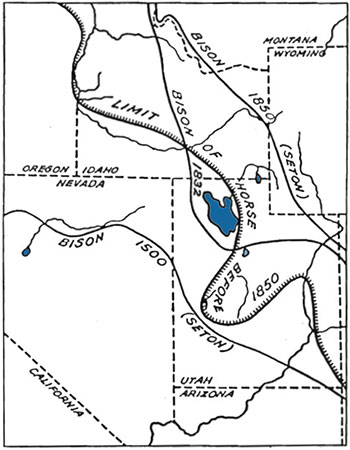Distribution of the Horse and Bison

This map of the Great Basin was prepared by Julian H. Steward, from his field notes of the receding extent of the Bison and the appearance of the horse into Shoshone lands, from about 1500 to 1850. Of note to me, this drawing shows that the Buffalo were in the greater Cache Valley as noted by older Shoshone Indians, to the early valley pioneers of 1856 and later. Julian H. Steward, was born January 31st, 1902, in Washington, D.C., and died February 6th, 1972, at Urbana, Illinois. He was an American anthropologist best known as one of the leading neoevolutionists of the mid-twentieth century and as the founder of the theory of cultural ecology.

He also did studies of the social organization of peasant villages, conducted ethnographic research among the North American Shoshone Indians and various South American Indians, and was an early proponent of area studies.
Between 1931 and 1936, Julian H. Steward made numerous trips throughout Nevada, Southern Idaho Western Utah, and the Owens Valley area of California, interviewing native people and recording the kinds of foods used historically within the Great Basin. Keep in mind, nearly all ofthe people he interviewed were in their late 70's or 80's at the time– which would indicate that most were born in the 1860's and 1870's, and who had gained a good deal of their information from their parents and grandparents.
We are deeply in debt to Mr. Steward, for his recording of the old traditions, from the tribal elders, as best he could access them. His recording of places names and cultural memories and traditions of the tribes or local groups provides as good a look at the past as we have in the present. His work is often noted and cited in many others work, since his time. Steward's research interests centered on "subsistence"—the dynamic interaction of man, environment, technology, social structure, and the organization of work—an approach Kroeber regarded as "eccentric," original and innovative. In 1931, Steward, pressed for money, began fieldwork on the Great Basin Shoshone under the auspices of Kroeber's Culture Element Distribution survey; in 1935 he received an appointment to the Smithsonian's Bureau of American Ethnography, which published some of his most influential works. Among them: Basin-Plateau Aboriginal Sociopolitical Groups in 1938, which "fully explicated" the paradigm of cultural ecology, and marked a shift away from the diffusionist orientation of American anthropology. He did change the world…
I was recently (2 June 2019) at the Fort Hall Sho-Ban Tribal museum, and noted that they reference Steward in several of their displays.